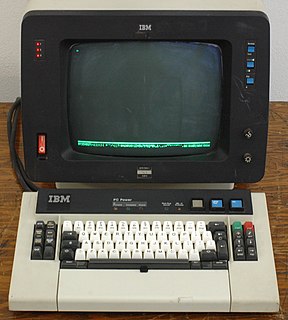DUCS (Display Unit Control System) was a teleprocessing monitor from CFS Inc. [1] It was one of two early local teleprocessing packages for IBM's DOS/VSE environment. DUCS provided an interface and access method for programmers to 'talk' to monitors. Such access methods later became known as APIs.
Transaction processing is information processing in computer science that is divided into individual, indivisible operations called transactions. Each transaction must succeed or fail as a complete unit; it can never be only partially complete.

International Business Machines Corporation (IBM) is an American multinational information technology company headquartered in Armonk, New York, with operations in over 170 countries. The company began in 1911, founded in Endicott, New York, as the Computing-Tabulating-Recording Company (CTR) and was renamed "International Business Machines" in 1924.

The user interface (UI), in the industrial design field of human–computer interaction, is the space where interactions between humans and machines occur. The goal of this interaction is to allow effective operation and control of the machine from the human end, whilst the machine simultaneously feeds back information that aids the operators' decision-making process. Examples of this broad concept of user interfaces include the interactive aspects of computer operating systems, hand tools, heavy machinery operator controls, and process controls. The design considerations applicable when creating user interfaces are related to or involve such disciplines as ergonomics and psychology.
Contents
Initially written for the IBM 2260 running under DOS on IBM mainframes, the original product was free for IBM users. With the advent of DOS/VS and the IBM 3270 series terminals, the original author commercialized the product, circa 1970. The company added transparent remote access about 1972.

The text-only monochrome IBM 2260 cathode ray tube (CRT) video display terminal plus keyboard was a 1964 predecessor to the more-powerful IBM 3270 terminal line which eventually was extended to support color text and graphics.

Mainframe computers or mainframes are computers used primarily by large organizations for critical applications; bulk data processing, such as census, industry and consumer statistics, enterprise resource planning; and transaction processing. They are larger and have more processing power than some other classes of computers: minicomputers, servers, workstations, and personal computers.

The IBM 3270 is a class of block oriented computer terminals introduced by IBM in 1971 normally used to communicate with IBM mainframes. The 3270 was the successor to the IBM 2260 display terminal. Due to the text colour on the original models, these terminals are informally known as green screen terminals. Unlike a character-oriented terminal, the 3270 minimizes the number of I/O interrupts required by transferring large blocks of data known as data streams, and uses a high speed proprietary communications interface, using coaxial cable.
The product is believed to be the first non-IBM publicly available commercial software package to transmit data via satellite. [2]

Application software is software designed to perform a group of coordinated functions, tasks, or activities for the benefit of the user. Examples of an application include a word processor, a spreadsheet, an accounting application, a web browser, an email client,a media player, a file viewer, an aeronautical flight simulator, a console game or a photo editor. The collective noun application software refers to all applications collectively. This contrasts with system software, which is mainly involved with running the computer.

In the context of spaceflight, a satellite is an artificial object which has been intentionally placed into orbit. Such objects are sometimes called artificial satellites to distinguish them from natural satellites such as Earth's Moon.



